The Secret Life of Stinky
Posted on Fri., May 15, 2015 by
There's more to the corpse flower than its giant bloom

A Corpse Flower, in full bloom, stands tall at night in The Rose Hills Foundation Conservatory for Botanical Science. Photograph by Kate Lain.
Behind the scenes at The Huntington, in a quiet greenhouse tucked away from public view, something big is brewing. There, among orchids of every description, thrive 43 representatives of one of the wonders of the plant kingdom: the Corpse Flower. Scientific name: Amorphophallus titanum, or A. titanum for short.
At this stage, each plant is simply a single leaf with a trunk-like stalk, dark green, patterned with lichen-like splotches, smooth and slightly yielding to the touch, topped by an array of leaflets. Stretching tall from large pots, some press their crowns against netting suspended from the ceiling high overhead.
They give no hint that they may one day die back to make way for the next step in their potential development: gargantuan stinky blooms that have brought visitors flocking to The Huntington since the first A. titanum flowered here in 1999.
"You could call it our 'giant panda,' " says Kathy Musial, curator of living collections and collections manager for The Huntington's botanical division.

In a greenhouse filled mostly with orchids, the trunk-like stalk of a single Amorphophallus titanum leaf presses against netting as it reaches for the sunlight. Photograph by Kate Lain.
If all 43 of the A. titanum were to bloom at once, the distinctive odor of rotting meat that gives the Corpse Flower its informal name would be overpowering. Just now, only the pleasant scent of loamy soil is apparent in the humid greenhouse air.
Meanwhile, over in The Rose Hills Foundation Conservatory for Botanical Science, last year's bloom, the fifth A. titanum to flower at The Huntington—offspring of the 1999 plant—is on display in its final fruit-bearing stage.
The successful cultivation of such a large number of these exotic plants so far from their natural habitat in the rain forests of Sumatra attests not only to unflagging public interest in the stinky bloom, but also to the breadth and depth of The Huntington's ongoing research into its ecology, physiology, and biology, and to the institution's mission of plant conservation.
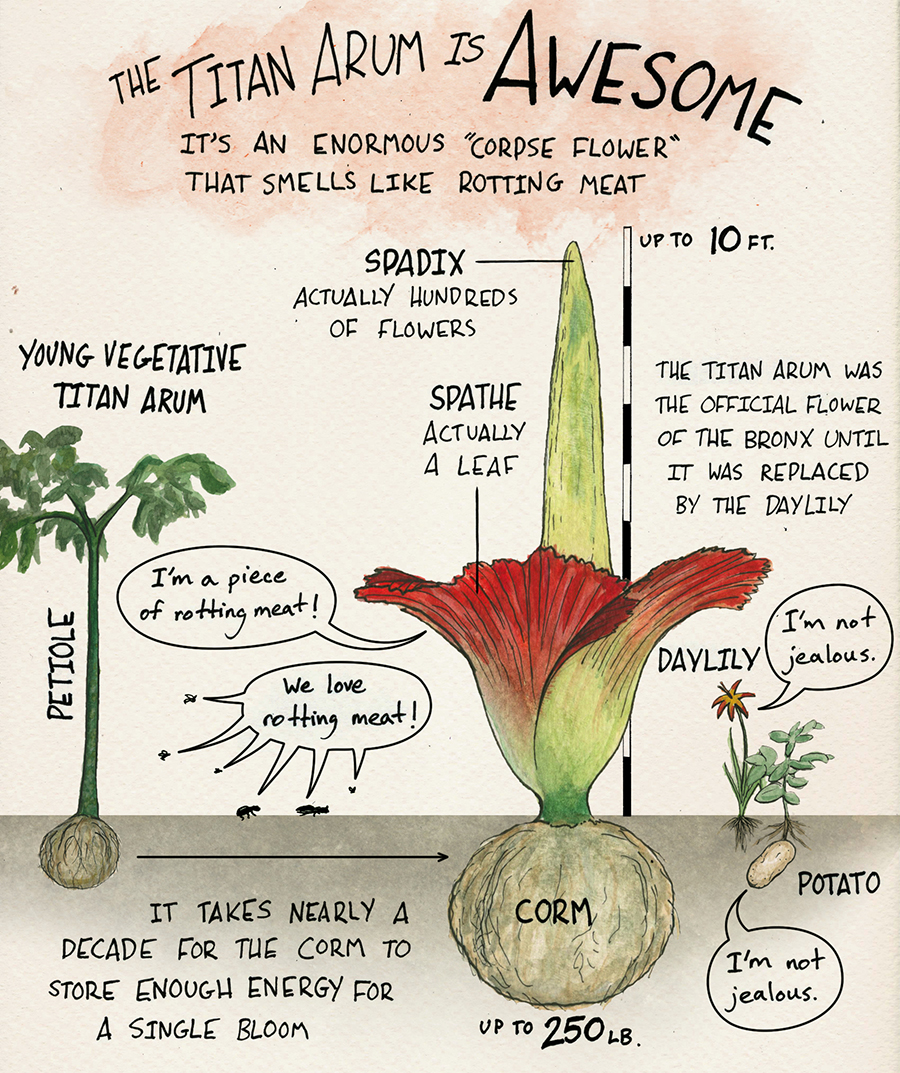
Adam Cole, the “wrangler” of the social media site Skunk Bear, National Public Radio’s Science Tumblr, saw The Huntington’s own Tumblr posts about its Corpse Flower bloom in August 2014. This inspired Cole to create, for the NPR site, the three watercolor and felt-tip pen illustrations that appear on the left. Illustration courtesy of Adam Cole/NPR.
"These are not just fabulous, wonderful, super-cool plants," Musial says. "Many tropical areas are being cleared for palm oil plantations, so everywhere you turn, there's something being wiped out. We want to share these things and, hopefully, inspire younger generations to get interested in the natural world," she says, "and to perhaps consider it as a career or a course of study, and as something that they feel is worth saving."
One of more than 3,000 aroid species, A. titanum is the megastar of the 200 species of plants within the Amorphophallus genus. Found in the tropics of Asia and Africa, some of these plant species are as impressive in size and appearance as the infamous Corpse Flower; many others are small tuberous herbs.
At the beginning of the plant's initial growing phase, during which it appears more and more tree-like, a leaf sprouts from a corm—a bulbous tuber that can weigh upwards of 250 pounds and looks something like a misshapen potato. (The largest corm to develop at The Huntington thus far weighed an estimated 50 pounds.)
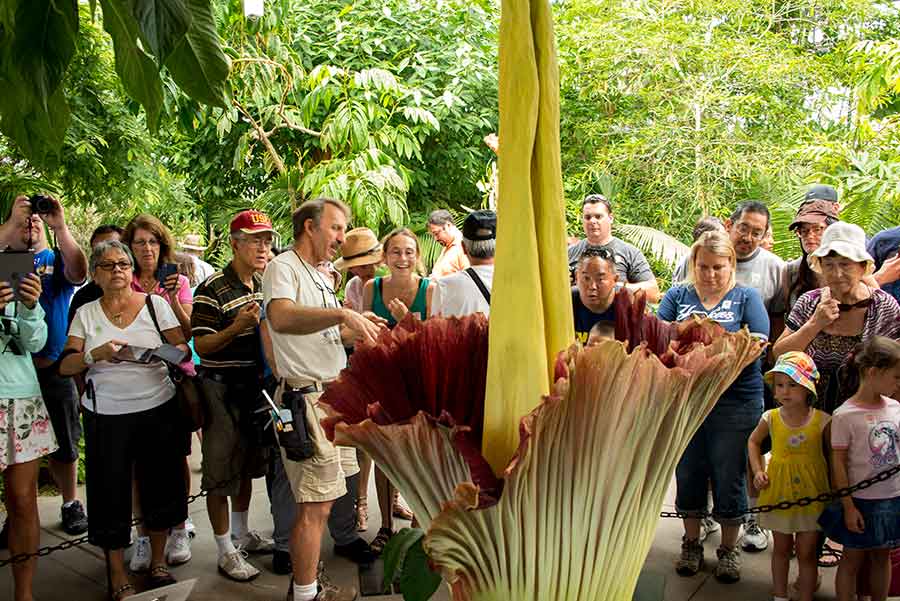
A crowd gathers to hear John Trager, curator of The Huntington’s desert gardens and collections, talk about the Corpse Flower’s bloom. Trager is immediately to the left of the flower.
Despite its size, it is a misnomer to call it the world's largest flower. What appears to be a velvety, ruffled petal structure in A. titanum's malodorous, enormous blooming phase is actually a spathe (a modified leaf) that sheaths the inflorescence—the flower-bearing part of the plant. Jutting several feet up above the spathe, a baguette-shaped spike called a spadix bears the clusters of small male and female flowers in segregated spirals at its base.
It is the plant kingdom's "most massive un-branched inflorescence," says Dylan Hannon, curator of the conservatory and tropical collections.
When the showy spathe withers away, the A. titanum undergoes another dramatic transformation: over a period of six to 12 months, each female flower will develop a thumb-sized, red-orange berry containing up to three seeds.
One major challenge, however, is the plant's penchant for keeping botanists in suspense about its intention to flower. When a spike erupts from its corm after a lengthy, leafless dormancy period, the difference in appearance between flower and leaf is "very subtle," Musial says.
"You have to wait for it to pop up out of the ground," Hannon says, "then maybe the new shoot that comes up starts looking a little different—maybe it's a little more swollen toward the base. And then, after many days, you determine that it's not going to be another leaf, it's going to be a flower."
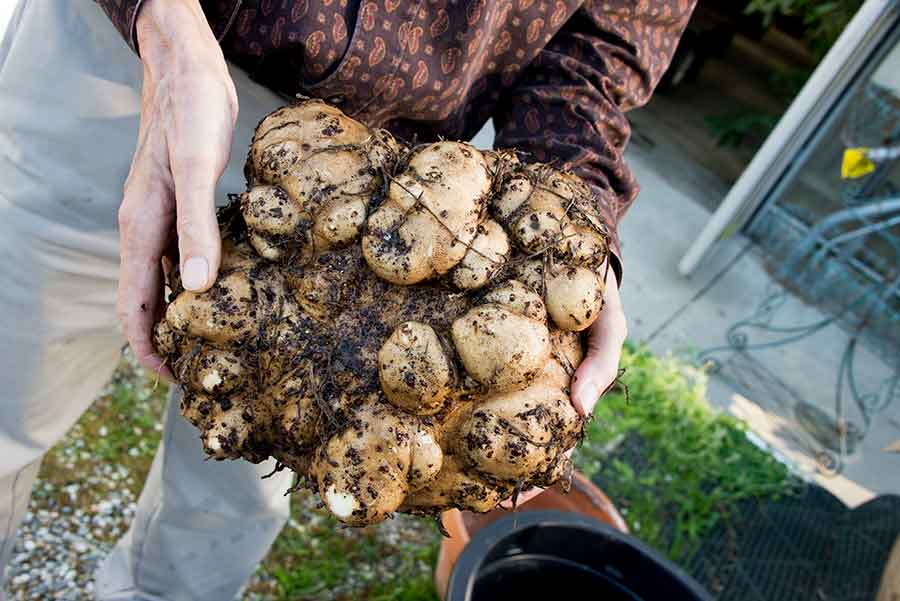
Dylan Hannon, curator of The Huntington’s conservatory and tropical collections, holds a large Corpse Flower corm in his hands.
And that's when things really heat up for all concerned at The Huntington. Although the A. titanum bloom develops over a period of weeks and can grow up to six inches a day, the life span of the full bloom, which may attain a diameter of four feet and a height of eight feet or more, is only one or two days.
In the flurry of activity that follows the realization that yes, a bloom is in the offing, and this is it, "you get all your cameras set up, and get the word out," Hannon says. As excitement builds, the Corpse Flower is moved to a position for optimum public viewing . . . and then the wait begins for it to unfold. "There's a little variation in how fast it can bloom," Hannon says wryly. "I mean, it is a plant. It's not reading the clock."
("It's hard to catch it in the act," quips Huntington spokesperson Lisa Blackburn.)
The suspense doesn't end with the bloom. When it withers, botanists wait months to learn if their efforts to pollinate the plant have produced fertile fruit. A. titanum, you see, doesn't self-pollinate. The female flowers on the spadix open first; the male flowers release their pollen only after the female flowers are no longer receptive. In the wild, this strategy invites cross-pollination with other A. titanum plants.
Without the natural pollen sources and insect pollinators of Sumatra's equatorial rain forest, the only hope for A. titanum's propagation outside of its natural environs lies with the plant's human caretakers.
That's where John Trager, curator of The Huntington's desert gardens and collections, comes in. In 1999, after the Huntington's historic first bloom made headlines worldwide, Musial suggested self-pollination of the A. titanum—thought to be impossible—to see if it could be done. As it turned out, it wasn't a stretch for Trager, drawing from his years of experience with the active propagation of diverse desert plants, to pioneer an experimental pollination technique that would work on the tropical A. titanum.
Knowing that he had to hasten the maturation of the male flowers in order to have pollen to work with, and combining science and everyday practicality, Trager cut some of the flowers off the spadix, took them home, put them in a bag of rotting apples and set the bag on his stovetop overnight, hoping that the ethylene gas generated by the apples would speed up the maturation process.
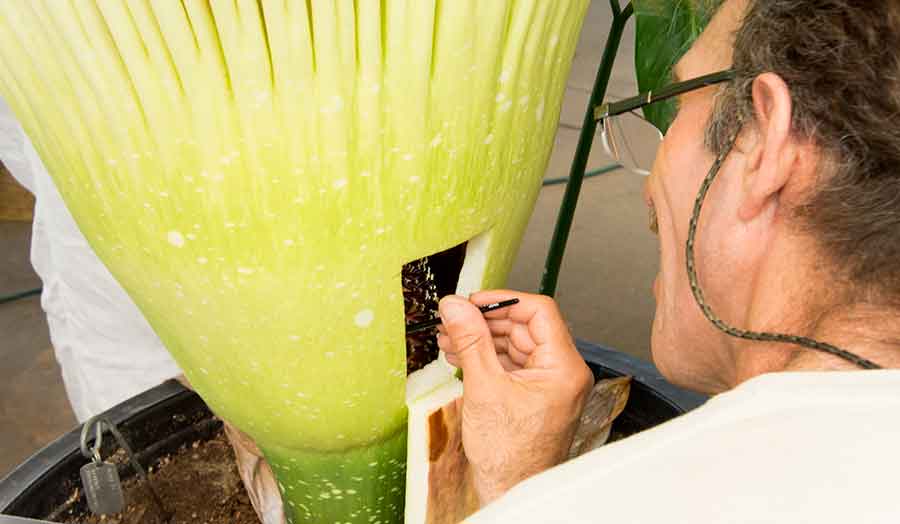
John Trager pollinates Amorphophallus titanum. Photographs by Kate Lain.
It worked up to a point, he says. "Normally when the male flowers are on the plant, the pollen is extruded out of the flower and hangs down in gummy strings. That didn't happen on my stovetop, so I had to cut open the anthers to extract the pollen." Using a dissecting scope, Trager was then able to pollinate several still-receptive female flowers. The process ultimately yielded 10 fertile seeds.
"To my knowledge," Musial observes, "nobody else has done this. If they have, they haven't publicized it."
When the same plant flowered again in 2002 (subsequently but unsuccessfully fertilized with frozen pollen donated by Fullerton Arboretum and fresh pollen Fed-Exed in from the University of Michigan), The Huntington sent its fresh pollen to UC Santa Barbara, where an A. titanum would shortly bloom. This pollen sharing produced a bountiful crop of fertile seeds that, coming full circle, is the source of the 43 plants now growing vigorously in The Huntington's orchid greenhouse.
The study of A. titanum at The Huntington includes numerous seed and pollen sharings among various institutions and universities and has sparked surprisingly diverse areas of research.
In 2009, Brazilian atmospheric chemist and botanical volunteer Antonio H. Miguel, together with John Trager, collected samples of volatile emissions from the inflorescence of "Son of Stinky," the nearly 7-foot bloom that grew that year from seed produced by The Huntington's original 1999 plant. The composition of the collected inflorescence vapors was analyzed by research scientists JiYi Lee (Chosun University, Department of Environmental Engineering, South Korea) and Douglas A. Lane (Environment Canada, Toronto), using a state-of-the-art instrument called a gas chromatograph–quadrupole mass spectrometer, capable of detecting upwards of 10,000 chemical compounds. Hundreds of compounds were identified and quantified, including the key "smelly" chemicals dimethyl disulfide and dimethyl trisulfide. Miguel presented the findings (co-authored with Lane, Lee, and Trager) at a research conference in Rio de Janeiro, Brazil, in 2011 under the title "Inflorescence Composition of Volatile Emissions of Amorphophallus titanum ( Araceae)."
"Worthy of note," the report summary states, "was a 'nose-detection' in the change of the smelly odor, from rotten eggs at the beginning, to boiled asparagus several hours after the start of the plant's bloom. Another interesting observation during the early hours after the opening of the spathe," the summary concludes, "was the occurrence of a gas-to-particle process which produced fine light-scattering particles."
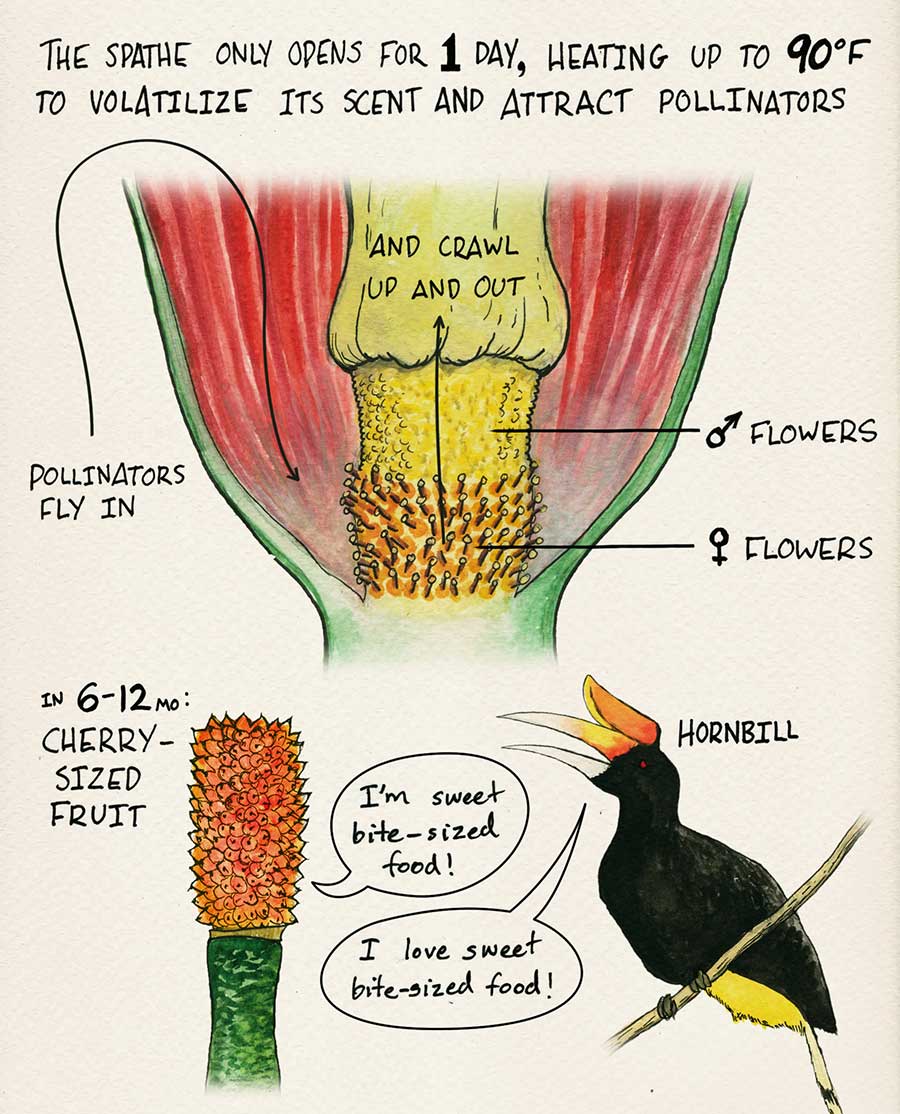
Illustration courtesy of Adam Cole/NPR.
"Basically," Miguel says, "it's the sulfur compounds that attract the insects." In the wild, "they come in thinking it's a dead piece of meat, they bring pollen and then," he says, "they do what the plants like them to do."
(Food for thought: Miguel, whose professional focus is air pollution in large urban centers, was "quite familiar with the compounds we found," he says, "because you find a lot of those in the atmosphere.")
For Hannon, a further area of interest is just how A. titanum found its way to countries so foreign to its native habitat. The specimen that bloomed at The Huntington in 1999, for instance, came from Arizona botanist Mark Dimmitt, who had obtained three seeds or cormlets from the Palmengarten in Frankfurt, Germany. These had been collected previously by the late James R. Symon in Sumatra in 1993.
"It seems probable that at least a couple of different introductions from the wild have resulted in all the cultivated plants of this species that we know of," says Hannon, adding that the provenance of many collected species is an underexplored area.
A. titanum's unusual properties have also recently fallen within the purview of cryopreservationist Raquel Folgado. A research fellow at The Huntington, Folgado is working to develop protocols for the conservation of plant germplasm (genetic material) by freezing it in liquid nitrogen. Cryopreservation's main advantage, she says, "is that you can store plant material for the long term, theoretically forever, because all biochemical reactions in the plant are stopped."
The day after she arrived at The Huntington last August to begin her two-year fellowship, Folgado helped Trager collect pollen from the most recent A. titanum bloom to freeze for future use. It had been pollinated earlier using frozen pollen obtained from Orange Coast College, but whether frozen pollen will prove viable in A. titanum's case has yet to be determined, as far as Trager is aware. An attempt to pollinate one of The Huntington's previous blooms using both fresh and frozen pollen failed.
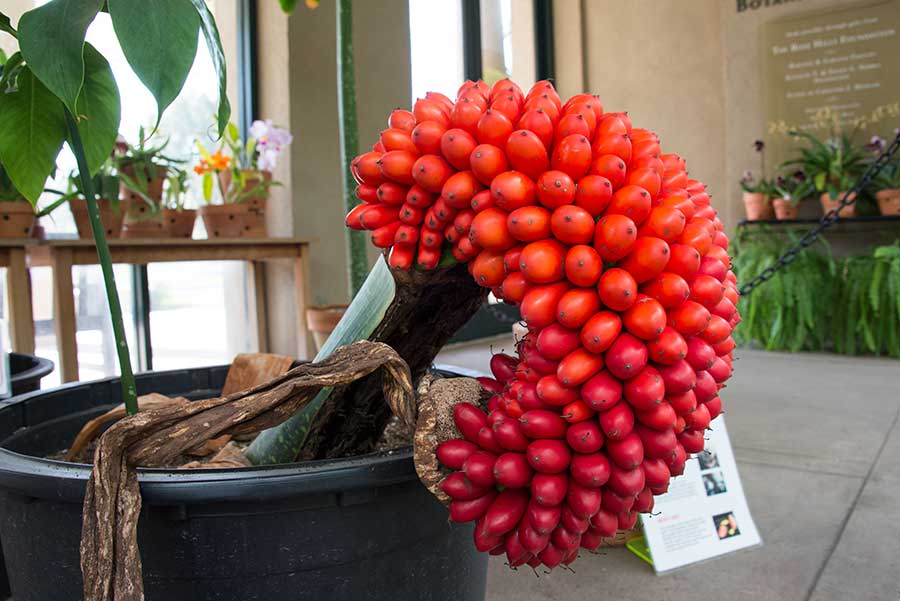
After the crimson spathe of a Corpse Flower bloom withers away, each female flower—over a period of six to 12 months—develops a thumb-sized, red or orange berry that contains one to three seeds. Photograph by Kate Lain.
"So it was time to try again," Trager says, "and prove that it can be done." So far, he is optimistic. In its pot in the Conservatory, the plant's fruit has formed exclusively on the side of the inflorescence where the frozen pollen was applied, he notes. "The fact that the fruiting structure has been getting heavier and heavier, yet still hasn't collapsed, is a good sign that something is still going on there.
"I suspect that it will have a combination of some fertile and some non-fertile fruits," Trager says, "because even when they're not fertilized, the red pericarp will develop to some extent. That's one reason we left it on display in the Conservatory, so that people could see this process."
After all, there is much more to the A. titanum than its unusual appearance and eye-watering stench, Trager stresses. "There's a whole ecology associated with it. Not just in the common vernacular sense of conservation, but in the interrelations of all of the other life forms that grow with it. There's a lot we can learn from this, and from the fact that it has such a different pollination strategy than people are used to: the typical birds and bees pollinators." Even the splotchy pattern on the leaf blade has significance, he observes.
It is thought to be "a self-preservation thing," he says. "The theory is that it catches the eye of large animals running through the forest, so that they would think it was a lichen-encrusted tree and would avoid running into it."
People often ask Hannon how they can grow their own A. titanum, he says. "You could," he tells them, "but you'd have to maintain warmth and humidity all year round, and you'd have to have a fairly big greenhouse, or maybe a big sun porch. Once it's growing, when it's leafed out, it's pretty standard care for a tropical plant."
"The tricky part is when it goes dormant," Hannon says. "What do you do with it when you're just looking at a pot with no leaf, no flower, no bud, nothing, just soil. You have to determine how much it should get watered. Should you keep it dry? How dry?"

Illustration courtesy of Adam Cole/NPR.
And while the Corpse Flower can no longer be called rare in the United States "because lots of people have flowered it now," Hannon says, it remains uncommon and unpredictable. If home growers prefer to try something smaller and less temperamental, other members of the aroid family, he points out, "are even more beautiful and interesting looking."
Still, "this thing is so outsized that it gets people's minds focused on plants, and that's a good thing," Hannon says. "From there they can learn about other plants and give a little more thought to botany and horticulture." (For more information about the aroid family, Hannon urges people to check out the International Aroid Society's website: aroid.org.)
At The Huntington, home so far to five Corpse Flowers in all their full-blown, pungent glory, it is only a matter of time before there is a sixth—and more, Trager says.
"Perhaps the reason that we haven't flowered them more frequently is because of space limitations," he says. "Apparently the bigger you pot 'em, the faster they grow and the quicker they flower." But with the impressive number of A. titanum now growing in The Huntington's greenhouse, "at some point," Trager says, "we'll probably have multiple plants flowering at once and have a really big stink."
"That's what we're hoping for," Musial agrees, "a mass flowering. I joked back in the early days that I wanted to have an 'Amorphophallus Stonehenge' down on the Australian garden lawn. Or, as John would more aptly call it, 'Stinkhenge.'"
Lynne Heffley is a freelance writer based in South Pasadena, Calif.